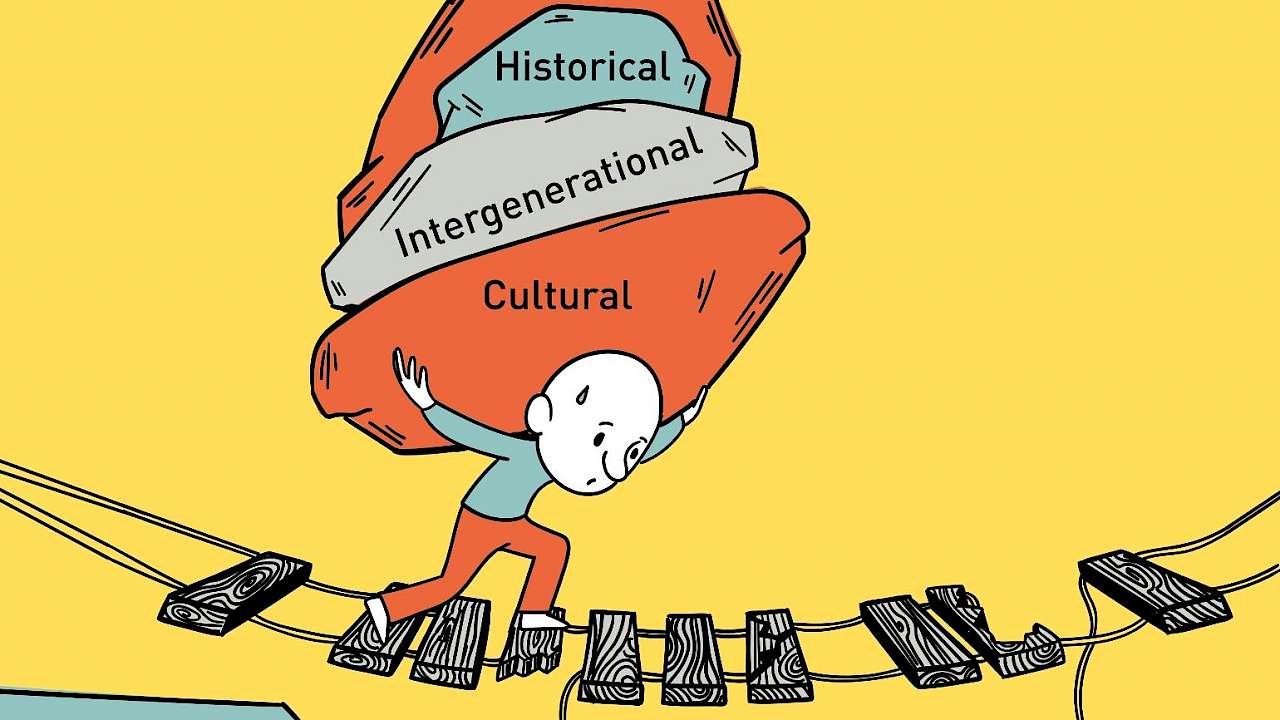Traumatic experiences affect how we understand and act in the world, including in the context of extremism. However, research and practice on relationships between trauma and extremism lags behind other areas of work.
The complexity of trauma
Trauma is complex. It has close links to other psychological and social factors; it can be understood on many levels, from the individual to the collective; and its effects depends on when it occurs. For these reasons, many see trauma as a factor that is too complex to be useful when considering extremism, and some claim that trauma is irrelevant altogether. Despite these challenges, we have recently seen an increase in research into the relationship between trauma and extremism, which has provided potential solutions to some of the issues facing this area.
When describing the challenges of extremism research, Gøtzche-Astrup once used the Persian poet Rumi’s story about a group of blind men who each touched one part of an elephant and then had to describe what it was. Because each man only knew a small part of the elephant, their descriptions differed, causing great confusion.
The metaphor of the elephant illustrates the challenges of extremism research: trying to move from a foot to the whole elephant; from individual stories to an overall tale.
This article aims to build a bridge between research on the role of trauma in extremism and extremism research in general. It also provides practitioners with a better understanding of the relevance of trauma in their work. To this end, I draw on my own research exploring different paths to extremism among a large segment of Norwegian youth. Hopefully, gaining a better understanding of the challenges and potential embedded in the relationship between individual trauma-specific stories and tales of overall extremism can create new and fruitful paths for research and interventions. This might contribute both to the way we interpret trauma and the tales we tell about it. By drawing attention to the complex ways in which different factors and experiences interact to inform dynamics and influences on extremism, this also contributes to the general field of extremism.
Trauma interacts and interrelates
Trauma is related to other factors, such as criminality and mental health, that are also relevant to extremism. This could be because some factors often appear together. For example, people who were exposed to crime when they were growing up are more likely to have encountered traumatic experiences. It could also relate to the varied ways we adapt when we experience something traumatic; for example, by developing anxiety or Post Traumatic Stress Disorder (PTSD), or even antisocial behaviour or extremist views. Responses to trauma can also be beneficial, for example through enhanced personal strength or appreciation of life, as mentioned in theories on post-traumatic growth.
While seeing trauma in relation to other factors and as part of a bigger picture is important, it can make it difficult to see its distinct influence. This dilemma is well known in wider extremism research. To handle this challenge, new methods have been developed which test theoretical frameworks through empirical data and individual stories, using complex statistical methods. As an example, my study on paths towards extremism empirically tested six categories of factors which were identified from a systematic literature review. Such frameworks may also be relevant in a trauma context.
My study illustrated how exposure to trauma and conduct problems can be related. Imagine an 18-year-old boy who experiences an armed robbery, committed by someone he does not know or identify with. In the aftermath, he has a desire to find somewhere to belong, or some sort of larger meaning in life (these ideas are reflected in different theoretical models, for example, Kruglanski’s Quest for Significance or Agnew’s General Strain Theory). Joining a group of lawbreakers, engaged in small-scale, racist criminality provides him with both meaning and belonging. Over time, this involvement develops into extremist attitudes and behaviour directed at the group that conducted the robbery.
This example points both to the relevance of interactions between factors over time such as social environment and crime, and the benefits of acknowledging the distinct influence of a specific trauma. Approaches that manage to keep both of these components in mind – seeing the relationship between the elephant’s toenail and the knee, or between the initial trauma and its complex and unfolding influences, have great potential to help interpret pathways into and out of extremism.
These more holistic methods can help inform research and contribute to tailor-made interventions that also exploit the adaptive nature of trauma responses. Overall, paying attention to how interactions and interrelations between specific events create individual stories can contribute greatly in building a foundation for understanding the overall tale of extremism.
These more holistic methods can help inform research and contribute to tailor-made interventions that also exploit the adaptive nature of trauma responses.
Understanding the layers
Trauma can be individual, intergenerational, historical and/or cultural. It can be experienced individually and collectively. Often, processes in the family, community, or society influence how a person understands and deals with trauma. Previous research has tended to overlook these layers.
Neglecting the different layers through which trauma is mediated and experienced can mean individual stories of trauma are only partially understood.
Neglecting the different layers through which trauma is mediated and experienced can mean individual stories of trauma are only partially understood. This is a challenge for extremism research as it similarly depends on understanding a complex web of personal and societal influences and experiences. Newer studies indicate that operationalising relevant factors more effectively, such as family environment or school satisfaction, and examining how such factors interact with one another and with trauma exposure, clarifies nuances of the stories about how and why people become involved in extremism. This again creates a more stable structure for the overall tale about what helps explain extremism.
For example, in my study, younger people had experienced more traumatic events. Picture a girl of 16 who is violently assaulted while walking home one evening. In the aftermath, she reaches out to others as part of a desire to create change so that no one experiences what she did. The people she comes to identify with help her understand what happened to her through an ideologically extreme framework. This makes sense to the girl, both because she can relate it to her trauma, but also because of the way her experience and perpetrators are talked about in her society. When attempting to create change, she bases her action on radical views, paving a way towards extremism.
Moving back and forth through the layers of understanding, from the girl’s experience, to its role in shaping her social networks, and how these impact her attitudes and behaviour, helps us identify the relevant individual stories, as well as how they can inform overall tales about pathways into and out of extremism. This can aid our interpretations of how singular experiences become part of complex interactions that influence extremist involvement. Furthermore, as Knott and Lee (2020) argue, attempts to develop a better understanding of individual stories by identifying the layers of experience and influence at work, can contribute to a better understanding of extremism overall. Ideally, understanding these joint and separate effects may lead to more specialised interventions.
Timing and sequence matters
Both timing and the sequence of events shape the influence of trauma. This is partially because traumatic events can happen once, or repeatedly across a person’s life. Trauma also alter and influence the effect of other factors such as social networks or financial stability. Furthermore, trauma can both trigger and protect against extremist involvement, or even be a consequence of engaging in extremism.
Few attempts have been made to fully understand how the sequence, in which trauma is experienced, impacts its effects. Similar problems can be found in the overall field of extremism. It is rare that one, distinct factor plays a clear role in shaping someone’s pathway into extremism. However, advanced statistical methods that investigate how the effect of different factors vary depending on timing and sequence have proven useful.
My study indicated that the path from trauma to conduct problems might evolve into support for political violence. Imagine an 18-year-old boy who after experiencing years of bullying, finds belonging and meaning in a group that commits armed robberies. He gets used to violence as a means of achieving his goals. Over time, his doubts about using violence decreases. Hence, when a situation arises where extremist actions seem appropriate, the gap between thought and action is reduced.
Paying attention to the way factors are sequenced over time is important and provides a way of understanding how trauma affects both radicalisation and deradicalisation. Using longitudinal or even life-course investigations can help us identify key points in an individual’s life where trauma has an impact on other factors, or where other factors have effects on trauma. Doing this demands that we use solid, theoretical frameworks, and are mindful of sequencing effects. These types of investigations are equally relevant for overall extremism research and can hopefully provide better understandings of not only the adverse, but also the adaptive or protective effects of different factors, which could highlight relevant points of intervention.
Helping practitioners to use the stories to understand the tale
Trauma has great potential to inform both research on extremism and interventions to counter extremism. Yet, this promise has not been fully realised. This short article has tried to demonstrate that in order to understand the effect of trauma on extremism, as well as the overall field of extremism, we need to make use of recent methodological developments. Such developments include the use of life-course or longitudinal investigations, as well as the move towards building empirical investigations on foundations of well-developed theoretical frameworks.
Using trauma in a way that truly makes use of its value requires several things.
- We need an increased understanding of the specific effect of trauma, but also how it is tied to and overlaps with other factors.
- We should work towards more precise identification of the different layers of individual, collective, and historical factors that trauma is shaped by and how they interact, both with each other and with other factors.
- We should pay attention to how the effect of trauma differs depending on timing and sequence in order to identify paths towards and away from extremism.
- We should design individually focused, holistic interventions that take account of both the individualised nature of traumas and their impacts, as well as the individual and their coping resources.
In sum, understanding the story that trauma can reveal about pathways to extremism, while not being overwhelmed by the complex nature of these processes, is key: both for developing an understanding of the role of trauma in extremism research, but also to further the overall tale of extremism. This understanding may also serve as a framework for designing more effective interventions which counter violent extremism. Thus, we have to develop sound theoretical frameworks that attend to the details of the individual stories while also keeping an eye on the overall tale to understand both the toenail and the whole elephant.
Anna Naterstad Harpviken is a clinical psychologist with a great interest in how we academically understand real-life challenges. Her work is positioned at the intersection of the individual and the society and focuses closely on violent extremism, radicalisation, and responses to crisis and trauma.
Read more
Agnew, R. (2010). A general strain theory of terrorism. Theoretical Criminology, 14(2), 131–153.Campelo, N., Bouzar, L., Oppetit, A., Pellerin, H., Hefez, S., Bronsard, G., Cohen D. https://tinyurl.com/2p8bajyw
Bouzar, D. (2018). Joining the Islamic State from France between 2014 and 2016: An observational follow-up study. Palgrave Communication, 4(137). https://tinyurl.com/34k2xmkd
Ellis, B. H., Miller, A. B., Schouten, R., Agalab, N. Y., & Abdi, S. M. (2020). The challenge and promise of a multidisciplinary team response to the problem of violent radicalization. Terrorism and Political Violence, 1-18. https://tinyurl.com/mryfdvcz
Ellis, B. H., Abdi, S. M., Horgan, J. G., Miller, A. B., Saxe, G. N., & Blood, E. (2015). Trauma and openness to legal and illegal activism among Somali refugees. Terrorism and Political Violence, 27(5), 857–883. https://tinyurl.com/ye28uacc
Knott, K., & Lee, B. J. (2020). Ideological transmission in extremist contexts: Towards a framework of how ideas are shared. Politics, Religion & Ideology, 21(1), 1-23. https://tinyurl.com/y5ruxm3j
Koehler, D. (2021). Violent extremism, mental health and substance abuse among adolescents: towards a trauma psychological perspective on violent radicalization. The Journal ofForensic Psychiatry & Psychology, 31(3), 455-472. https://tinyurl.com/4vj5r6bh
Kruglanski, A. W., Gelfand, M. J., Bélanger, J. J., Sheveland, A., Heti- arachchi, M., & Gunaratna, R. (2014). The psychology of radicalization and deradicalization: How Significance quest impacts violent extremism. Political Psychology, 35(S1), 69–93. https://tinyurl.com/2uf9wkzu
Nivette, A., Eisner, M., & Ribeaud, D. (2017). Developmental predictors of violent extremist attitudes: A test of general strain theory. Journal of Research in Crime and Delinquency, 54(6), 755–790. https://tinyurl.com/mu5xep4x
Copyright Information
©Rebecca Stevens| CSR is available under a Creative Commons 4.0 BY-NC-SA licence.






